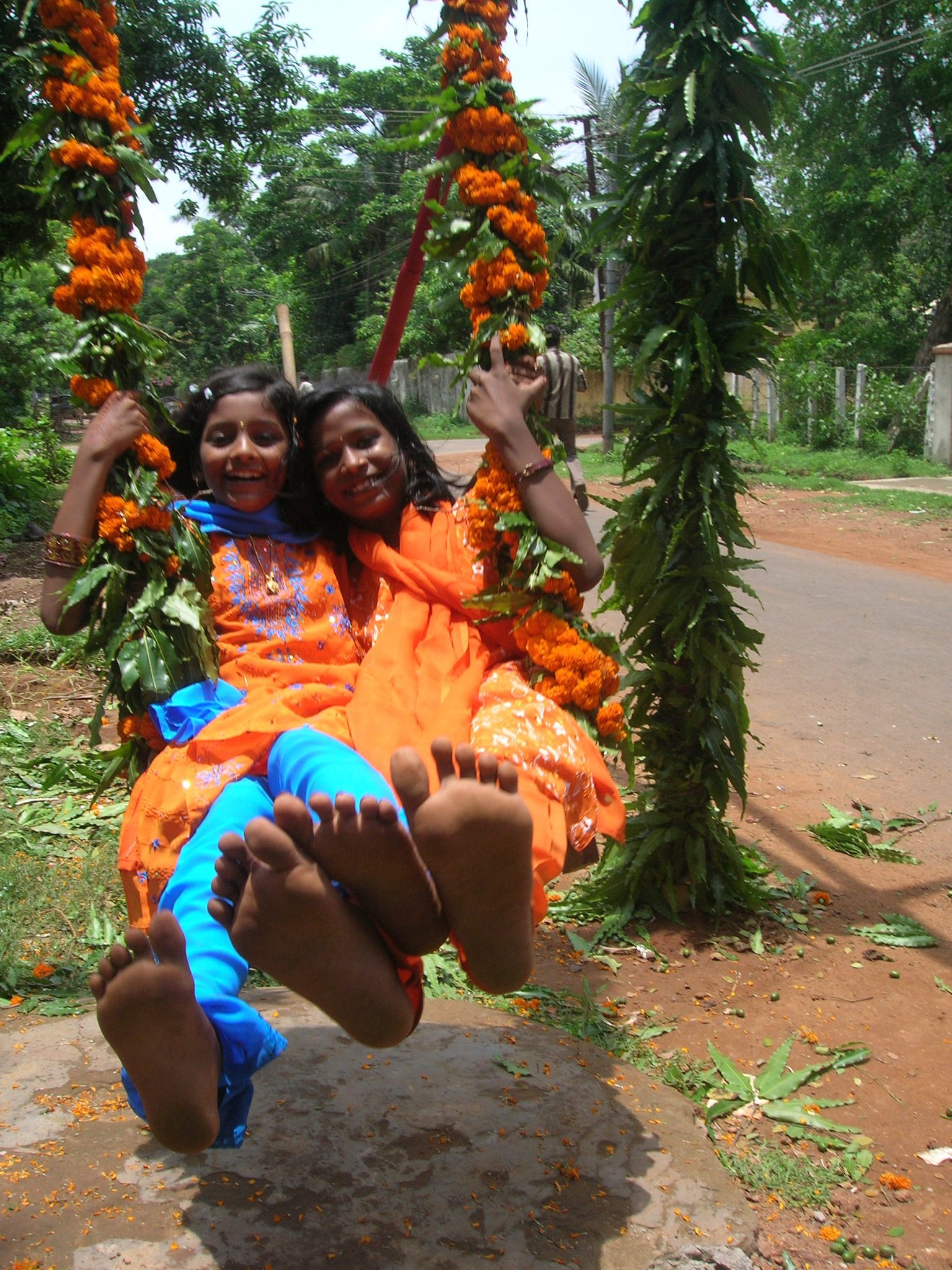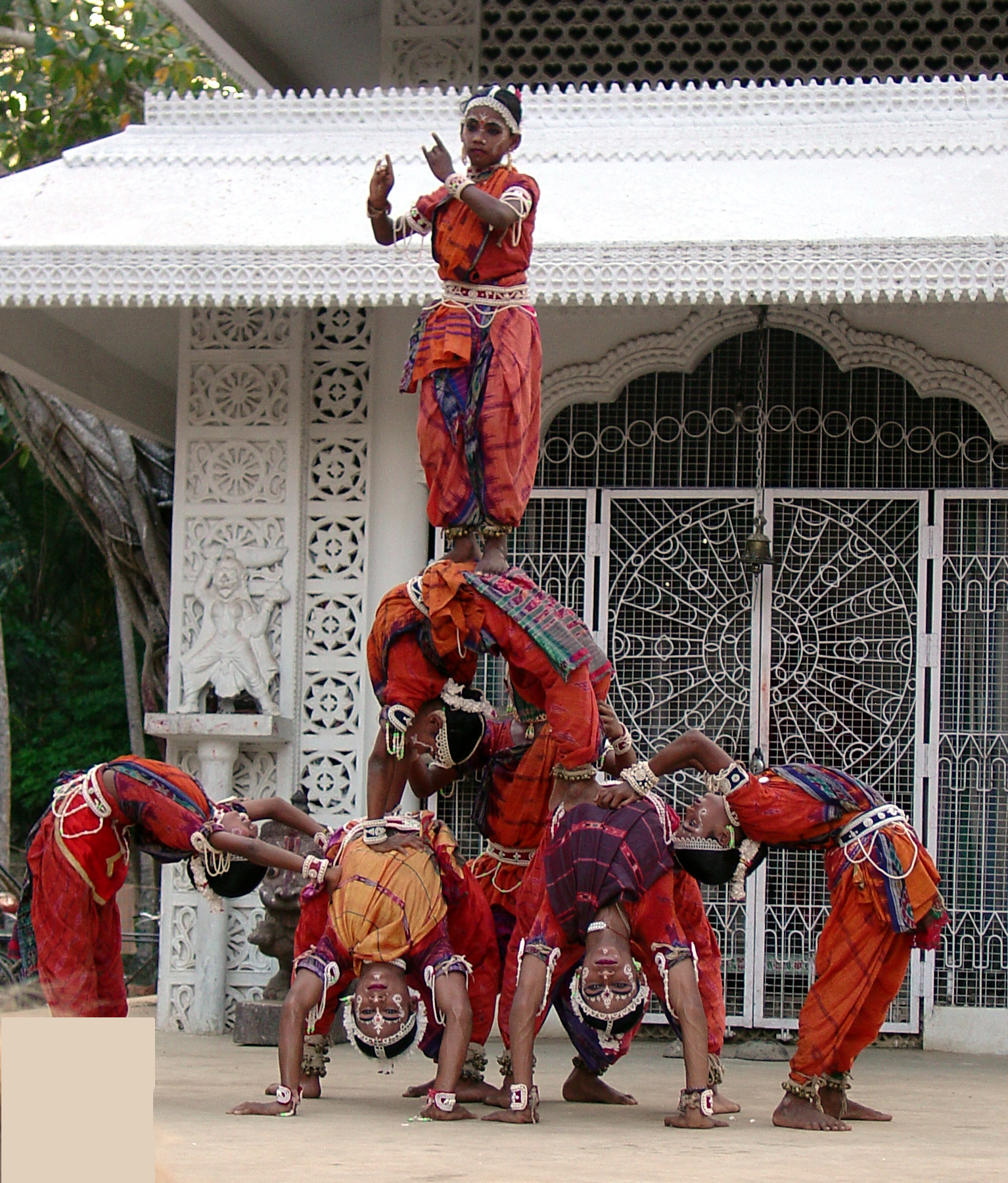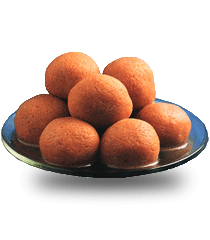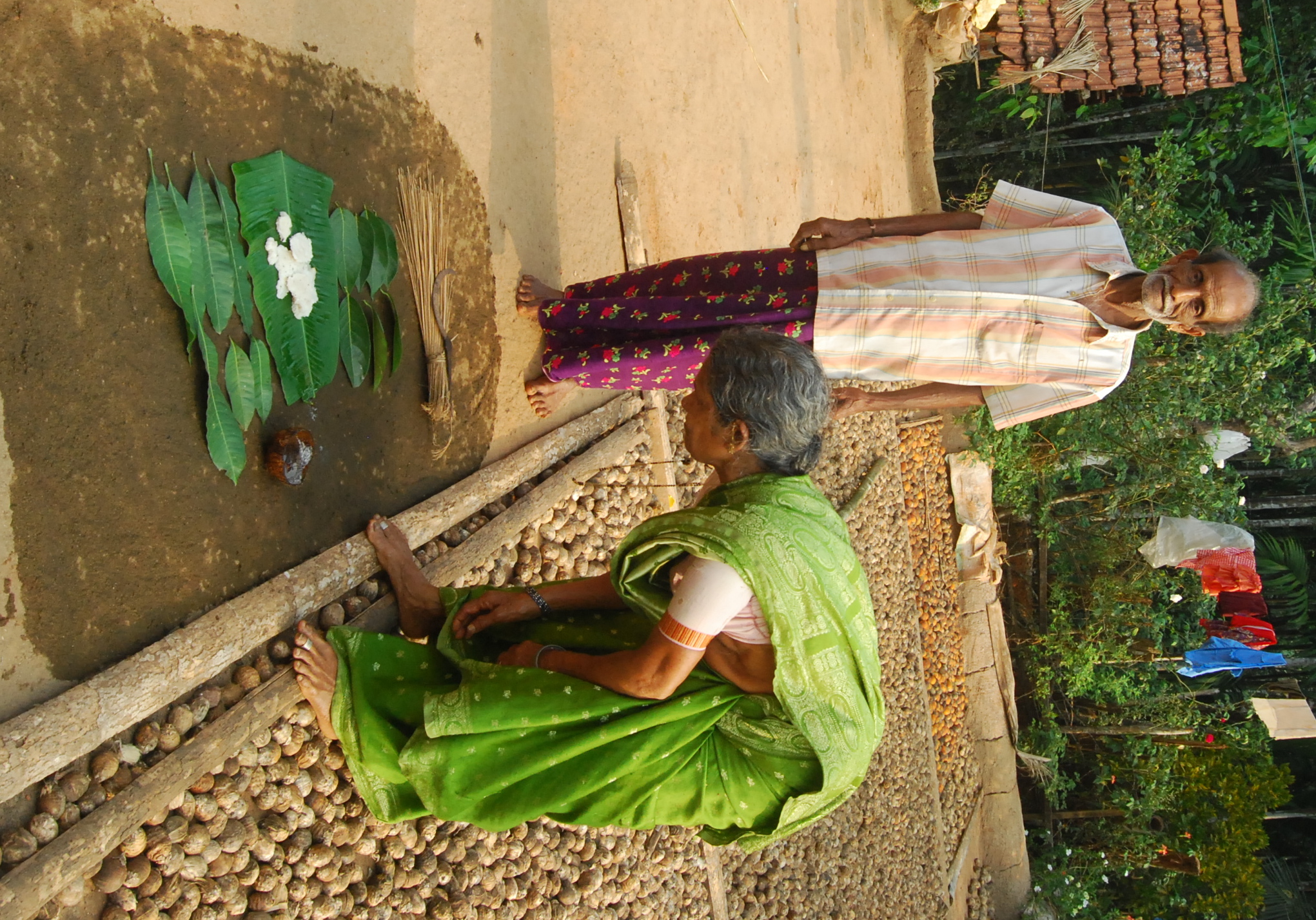|
Raja Parba
Raja Parba (, ), also known as ''Mithuna Sankranti'', is a three-day-long festival of womanhood celebrated in Odisha, India. The second day of the festival signifies beginning of the solar month of Mithuna from, which the season of rains starts. Mythology It is believed that the mother Goddess Earth or the divine wife of Lord Vishnu undergoes menstruation during the first three days. The fourth day is called ''Vasumati Snana'', or ceremonial bath of Bhudevi. The term Raja came from the Sanskrit word '''Rajas''' which means menstruation and when a woman menstruates, she is called Rajaswala''' or a menstruating woman, and in medieval times the festival became more popular as an agricultural holiday marking the worship of Bhudevi, who is the wife of lord Jagannath. A silver idol of Bhudevi is still to be found in the Puri Temple beside Lord Jagannath . Rajaparba It falls in mid June, the first day is called Pahili Raja, second day is Mithuna Sankranti, third day is Bhudaaha or Bas ... [...More Info...] [...Related Items...] OR: [Wikipedia] [Google] [Baidu] |
Raja Doli Khela Odia Festival
''Raja'' (; from , IAST ') is a royal title used for South Asian monarchs. The title is equivalent to king or princely ruler in South Asia and Southeast Asia. The title has a long history in history of South Asia, South Asia and History of Southeast Asia, Southeast Asia, being attested from the Rigveda, where a ' is a Rigvedic tribes, ruler, see for example the Battle of the Ten Kings, ', the "Battle of Ten Kings". Raja-ruled Indian states While most of the Indian subcontinent, Indian salute states (those granted a Salute#Heavy arms: gun salutes, gun salute by the The Crown, British Crown) were ruled by a Maharaja (or variation; some promoted from an earlier Raja- or equivalent style), even exclusively from 13 guns up, a number had Rajas: ; Hereditary salutes of 11-guns : * the Raja of Pindrawal * the Raja of Morni * the Raja of Rajouri * the Raja of Ali Rajpur State, Ali Rajpur * the Raja of Bilaspur State, Bilaspur * the Raja of Chamba State, Chamba * the Raja of Fa ... [...More Info...] [...Related Items...] OR: [Wikipedia] [Google] [Baidu] |
Gotipua
Gotipua is a traditional dance form in the state of Odisha, India, and the precursor of Odissi classical dance. It has been performed in Orissa for centuries by young boys, who dress as women to praise Jagannath and Krishna. The dance is executed by a group of boys who perform acrobatic figures inspired by the life of Radha and Krishna. The boys begin to learn the dance at an early age until adolescence, when their androgynous appearance changes. In the Odia language, Gotipua means "single boy" (''goti-pua''). Raghurajpur, Odisha (near Puri) is a historic village known for its Gotipua dance troupes. The dance of the Gotipuas is accompanied by traditional Odissi music with the primary percussion being the Mardala. Dancers To transform into graceful feminine dancers the boys do not cut their hair, instead they style it into a knot and weaving garlands of flowers into it. They make up their faces with mixed white and red powder. ''Kajal'' (black eyeliner) is broadly applied around ... [...More Info...] [...Related Items...] OR: [Wikipedia] [Google] [Baidu] |
June Observances
June is the sixth month of the year in the Julian and Gregorian calendars and is the second of four months to have a length of 30 days, and the third of five months to have a length of less than 31 days. June contains the summer solstice in the Northern Hemisphere, the day with the most daylight hours, and the winter solstice in the Southern Hemisphere, the day with the fewest daylight hours (excluding polar regions in both cases). June in the Northern Hemisphere is the seasonal equivalent to December in the Southern Hemisphere and vice versa. In the Northern Hemisphere, the beginning of the traditional astronomical summer is 21 June (meteorological summer begins on 1 June). In the Southern Hemisphere, meteorological winter begins on 1 June. At the start of June, the sun rises in the constellation of Taurus; at the end of June, the sun rises in the constellation of Gemini. However, due to the precession of the equinoxes, June begins with the sun in the astrological sign of ... [...More Info...] [...Related Items...] OR: [Wikipedia] [Google] [Baidu] |
Festivals In Odisha
A festival is an event ordinarily celebrated by a community and centering on some characteristic aspect or aspects of that community and its religion or cultures. It is often marked as a local or national holiday, Melā, mela, or Muslim holidays, eid. A festival constitutes typical cases of glocalization, as well as the high culture-low culture interrelationship. Next to religion and folklore, a significant origin is agriculture, agricultural. Food is such a vital resource that many festivals are associated with harvest time. Religious commemoration and thanksgiving for good harvests are blended in events that take place in autumn, such as Halloween in the northern hemisphere and Easter in the southern. Festivals often serve to fulfill specific communal purposes, especially in regard to commemoration or thanking to the gods, goddesses or saints: they are called patronal festivals. They may also provide entertainment, which was particularly important to local communities before ... [...More Info...] [...Related Items...] OR: [Wikipedia] [Google] [Baidu] |
Teej
Teej ( ne, तीज, Tīja, translit-std=ISO) is the generic name for a number of Hindu festivals that are celebrated by women and girls. and welcome the monsoon season and are celebrated primarily by girls and women, with singing, dancing, enjoyment and prayer rituals. The monsoon festivals of Teej are primarily dedicated to Parvati and her reunion with Lord Shiva. Women often fast in celebration of ''Teej.'' Hartalika Teej is celebrated in hilly and terai regions of Nepal and most of the parts of North India (Bihar, Uttar Pradesh, Madhya Pradesh, Uttarakhand, and Rajasthan). ''Teej'' festivals are traditionally observed by women to celebrate the monsoons during the months of Shravan and Bhadrapada of Hindu calendar. Women pray to Parvati and Shiva during ''Teej''. Etymology refers to the third day that falls every month after the new moon (), and the third day after the full moon night of every lunar month. According to Kumar (1988), and fall in Bhadrapada. ref ... [...More Info...] [...Related Items...] OR: [Wikipedia] [Google] [Baidu] |
Sisua Village
Sisua is a medium-sized (223,980 acres) village in the Salipur taluk/mandal/tehsil/block of Cuttack district in the state of Odisha (previously called "Orissa" ), India, close to the new Sisua Village Jagannath (form of Vishnu) Temple (Hindu Temple) (Not to be confused with the Shree Jagannath temple, Puri, approximately 100 km South of the Sisua Village Jagannath Temple). The village lies South of Cuttack to Kendraparda road (Highway 9A) left of Sisua village road if traveling South. As of 2009 Kantapara is the gram panchayat (GP part of a group) of Sisua village In late October 1999 the village was one of many affected by the Super Cyclone that devastated the area after hitting the East coast of Odisha. The village consists of approximately 250 dwellings, has its own post office (Contact address: Postmaster, Post Office Sisua (BRANCH OFFICE), Cuttack, Odisha (OD), India (IN), Pin Code:- 754202) but has no railway station of its own therefore it cannot be reached dire ... [...More Info...] [...Related Items...] OR: [Wikipedia] [Google] [Baidu] |
Salepur
Salepur (also known as Salipur) is a town in the district of Cuttack, and the headquarters of the Salipur block. It is situated near the bank of holy river ''Chitrotpala'' mother of Ganga, 25 km from the city of Cuttack and 55 km from the state capital Bhubaneswar. Name's Relevance The name Salepur is primarily derived from the combination of two words viz. sali (Paddy) and Pur (Place). It is due to the reason that Salepur belt is one of the largest producers of Paddy in the State of Odisha because of its highly fertile soil. Transport By Road: Salepur is well connected to all the nearby cities and towns by roads. SH-9A connects it to NH-16 which connects to Kolkata and Chennai. Besides SH-9A also connects to the nearby cities/towns like Cuttack, Kendrapara, Pattamundai, Rajnagar, Aul, and Chandbali. By Rail: The nearest major railway station at Cuttack is well connected to most of the cities both within and outside the state, which include New Delhi, Calcutta, Mad ... [...More Info...] [...Related Items...] OR: [Wikipedia] [Google] [Baidu] |
Odia Literature
Odia literature is literature written in the Odia language, mostly from the Indian state of Odisha. The modern Odia language is mostly formed from Tadbhava words with significant Sanskrit (Tatsama) influences, along with loanwoards from Desaja, English, Hindustani (Hindi/Urdu), Persian, and Arabic. Its earliest written texts date from around 1000 CE. The earliest Odia newspaper was '' Utkala Deepika'', first published on August 4, 1866. Historians have divided Odia literature into five main stages: Old Odia (800 AD to 1300 AD), Early Medieval Odia (1300 AD to 1500 AD), Medieval Odia (1500 AD to 1700 AD), Late Medieval Odia (1700 AD to 1850 AD) and Modern Odia (1870 AD to present). Further subdivisions, as seen below, more precisely chart the language's development. 4th century BC The creativity and development of the Odia language and literature can be seen in its spoken forms, such as folk tales, and in written forms, such as rock edicts and manuscripts. Songs sung to m ... [...More Info...] [...Related Items...] OR: [Wikipedia] [Google] [Baidu] |
Odia Language
Odia (, ISO: , ; formerly rendered Oriya ) is an Indo-Aryan language spoken in the Indian state of Odisha. It is the official language in Odisha (formerly rendered Orissa), where native speakers make up 82% of the population, and it is also spoken in parts of West Bengal, Jharkhand, Andhra Pradesh and Chhattisgarh. Odia is one of the many official languages of India; it is the official language of Odisha and the second official language of Jharkhand. The language is also spoken by a sizeable population of 700,000 people in Chhattisgarh. Odia is the sixth Indian language to be designated a classical language, on the basis of having a long literary history and not having borrowed extensively from other languages. The earliest known inscription in Odia dates back to the 10th century CE. History Odia is an Eastern Indo-Aryan language belonging to the Indo-Aryan language family. It descends from Odra Prakrit, which evolved from Magadhi Prakrit, which was spoken in east India ... [...More Info...] [...Related Items...] OR: [Wikipedia] [Google] [Baidu] |
Keddaso
Keddaso also spelled Keddasa (Tulu language, Tulu: ''keḍḍasa ಕೆಡ್ಡಸ'' ), or Bhumi Puje, is popularly known as the "festival of worshipping Mother Earth" in the Tulunad, Tulu Nadu region of South India. Mother Earth (Bhoomi Devi) gets menstruate and the day is celebrated holistically in Tulunad in the name of ‘Keddasa’. This is an important four-day fertility worship celebrated in the closing days of Tulu people, Tulu month Ponny (Gregorian month February). This festival shows the environmental awareness of the people residing at that region. Rituals Keddasa normally falls in the month of February and is celebrated over three days named Keddasa, Nadu Keddasa and Kade Keddasa. This celebrated in the winter of this region, where its believed that Bhoomi Devi gets Menstruation, menstruated and becomes fertile for farming. For three days, the Goddess undergoes Ashaucha and takes rest. People in the region do not perform any farming activity to give the Mother, who ... [...More Info...] [...Related Items...] OR: [Wikipedia] [Google] [Baidu] |
Podo Pitha
Poda pitha (Odia: ପୋଡ଼ ପିଠା) is slow-cooked pitha. It is made by slowly baking fermented rice, black gram, grated coconut and jaggery overnight. Its crust is slightly burnt, while the inside is soft and white. ''Poda pitha'' is generally made during Raja Parba. It is served to Lord Jagannath and his siblings at Mausi Maa Temple on their way back after Ratha-Yatra, from Gundicha Temple to Jagannath Temple, Puri. See also * Odia cuisine * Raja Parba * Jagannath Temple, Puri The Jagannath Temple is an important Hindu temple dedicated to Jagannath, a form of Vishnu - one of the Trimurti, trinity of supreme divinity in Hinduism. Puri is in the state of Odisha, on the eastern coast of India. The present temple was ... References {{Indian Dishes Odia cuisine ... [...More Info...] [...Related Items...] OR: [Wikipedia] [Google] [Baidu] |
Odisha
Odisha (English: , ), formerly Orissa ( the official name until 2011), is an Indian state located in Eastern India. It is the 8th largest state by area, and the 11th largest by population. The state has the third largest population of Scheduled Tribes in India. It neighbours the states of Jharkhand and West Bengal to the north, Chhattisgarh to the west, and Andhra Pradesh to the south. Odisha has a coastline of along the Bay of Bengal in Indian Ocean. The region is also known as Utkala and is also mentioned in India's national anthem, " Jana Gana Mana". The language of Odisha is Odia, which is one of the Classical Languages of India. The ancient kingdom of Kalinga, which was invaded by the Mauryan Emperor Ashoka (which was again won back from them by King Kharavela) in 261 BCE resulting in the Kalinga War, coincides with the borders of modern-day Odisha. The modern boundaries of Odisha were demarcated by the British Indian government when Orissa Province wa ... [...More Info...] [...Related Items...] OR: [Wikipedia] [Google] [Baidu] |



.jpg)

_spotted_at_Kambalakonda_01.jpg)




